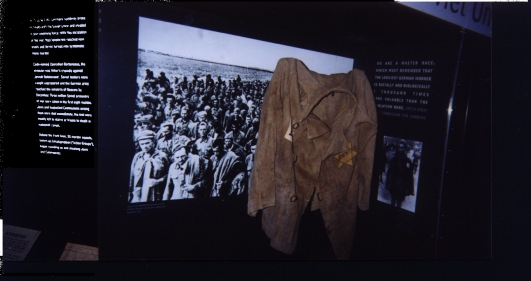British Imperial War Museum - Invasion
of the Soviet Union display (Holocaust Exhibition)
The adjoining image is of the only display case within the IWM that
gives any serious attention to the
fate of Soviet POWs. (1)
The main text in that display case:
>On 22 June 1941 Germany suddenly broke its treaty with the
Soviet Union and invaded in overwhelming force. With this
escalation of the war, Nazi fanaticisim reached new levels and terror
turned into systematic mass murder. [The reference is to mass
murder of
Jews --- which began in the summer of 1941.]
Code-named Operation Barbarossa, the invasion was Hitler's
crusade gainst 'Jewish Bolshevism'. Soviet leaders were caught
unprepared and the German army reached the outskirts of Moscow by
December. Three million Soviet prisoners of war were taken in the
first eight months. Jews and suspected Communists among them were
shot immediately; the rest were mostly left to starve or freeze to
death
in makeshift camps.
Behind the front lines, SS murder squads, known as
Einsatzgruppen ('Action Groups"), began
rounding up and shooting Jews and Communists.<
About half of the significant visuals within the "Soviet Invasion"
display case and about
half the main text bring to mind Jewish POWs and the fate of Jews in
German hands -- but under 5% of dead Soviet POWs were Jews. (And
Jewish persecution and death is quite well covered in the adjoining
1195
square meteres of the IWM exhibition.)
No 'innocent' visitor will come away from this "Soviet Invasion"
Imperial War Museum display case with a full sense of the massive
Gentile Soviet death tolls of 1941 and early 1942. To convey
effectively these Gentile death tolls -- and to do justice to the
Soviet
Barbarossa experience -- visuals that direct attention to the
Soviet Jewish POW experience need to be removed from the display.
And the main text of the display needs to state clearly and forcefully
-- in a sentence not mentioning Jews -- that the Germans captured
over two million Gentile Soviets in 1941, had killed most of these
prisoners by the spring of 1942, and total Soviet military losses for
1941 were circa three million.
For an exchange on H-Holocaust in 2006 between myself and the writer of
the text quoted above go to http://www.h-net.org/~holoweb/
and, employing the search function at the left, enter "Paulsson Petrie
'forgotten' holocausts". For a wider discussion of representation
issues and also a follow up to the Petrie-Paulsson exchange enter
"Rhetoric of 'forgotten' holocausts".
(1) The image is composed of two photos joined
together, and both the main text (left) and Star of
David
worn by the POW in
the small photo (right) are enhanced -- but not the Star of David on
the
prisoner's coat in the foreground of the dispay case. There are
other 'mentions' of Soviet POW losses within the Holocaust Exhibition
beyond the pictured display case, but they are simply passing mentions.
>>>>>>>>>>>>>>>>>>>>>>>>>>>>>>>>>>>>>>>>>>>>>>>>>>>>>>>>>>>>>>>>>>>>>>>>>>>>>>>>>>>>>>>>>>>>>>>
Coverage of Russian losses / Soviet POW losses in the Museum's
World War I & II exhibits
The Imperial War Museum does direct
attention to Russian losses in World War I, e.g.: "One million
six hundred
thousand killed ... over four million wounded ... [Russia] could not
sustain such losses."
But a few hundred feet away,
within its World War II exhibit, a film entitled
'Barbarossa' gives no
indication of total 1941 Soviet losses and leaves
listeners with the impression that the Germans captured less than a
million prisoners in 1941, not over two million. (And the film
gives
no indication that most of those Soviet 1941 prisoners were dead within
six months.)
And near the 'Barbarossa' film screen is a display case titled
"Prisoners of War" that avoids any hint that Germans were responsible
for a holocaust of Soviet POWs. The only reference to Soviet POWs:
"The
war of rapid movement ... lead to unprecedented numbers of combatants
being taken prisoner. Conditions varied greatly in prisoner of
war camps. While most POW's suffered levels of privation
and boredom, the situation of Soviet and German captives on the Eastern
front was particularly harsh."
(The accepted figure for Soviet POW death/ murder at German hands is
three million three hundred thousand. The "particularly harsh"
statement quoted above is the sole reference within the Museum's World
War II display cases to the German army's unprecedented slaughter of
millions of POWs.)
>>>>>>>>>>>>>>>>>>>>>>>>>>>>>>>>>>>>>>>>>>>>>>>>>>>>>>>>>>>>>>>>>>>>>>>>>>>>>>>>>>>>>>>>>>>>>>>>
For the memorial to Soviet WWII losses located just outside IWM's
boundaries within a public park see:
http://209.133.54.73/~jon/DSC00054.JPG.medium.html (building in
the background is the Museum)
http://209.133.54.73/~jon/DSC00053.JPG.medium.html
http://209.133.54.73/~jon/DSC00055.JPG.medium.html
(text on monument)
>>>>>>>>>>>>>>>>>>>>>>>>>>>>>>>>>>>>>>>>>>>>>>>>>>>>>>>>>>>>>>>>>>>>>>>>>>>>>>>>>>>>>>>>>>>>>>>>
See >http://www.berkeleyinternet.com/ushmm/soviet.html<
for the US Holocaust's Museum's treatment of the 1941 Soviet losses.
And some readers may also be interested in the systematic
misrepresentation of the history and meanings of the word "holocaust"
by Holocaust
scholars documented at >http://www.berkeleyinternet.com/holocaust/<
Jon Petrie (jon_petrie@yahoo.com)
